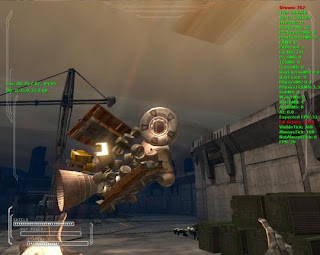We finally got around to testing out CellFactor: Revolution for ourselves this week. To recap, CellFactor is a free downloadable game designed to show-off those fancy Ageia PhysX cards we're sure at least two or three of you may have purchased for your gaming PCs.
CellFactor is basically a straightforward fragfest, either with bots or with real players over a LAN. You can choose from three difference character types, we spent all of our time with the Bishop character, whose psi-powers seemed best suited to trying out the advanced physics.
CellFactor's PhysX card support lets you can gather objects into a floating ball of impending death.
(Credit: CNET)We definitely experienced some ooh and ahh moments in CellFactor. Psychically redirecting a stream of flowing, blobby lava into an enemy's face is new. We also liked the various tricks you can pull off with the plentiful objects in the game, such as gathering boxes in a floating formation in front of you and then firing them off at your enemies one by one. Being able to part rubble like the Red Sea is fun as well.
We didn't conduct traditional benchmark testing with this card since it seems fairly pointless. What would we compare it to? But we can say that we tried it in two different PCs of varying capability.
The first was a Gateway FX530XT, complete with 4GB of RAM, an overclocked Intel Quad Core Extreme chip, and a GeForce 8800 GTX graphics card (an update from the last Gateway we reviewed). That system handled the PhysX card fine at 1,280 x 960, with all the graphical bells-and-whistles turned on and the frame rate holding consistently around 40 frames per second or so, which was very playable.
The Gateway DX430X was less speedy. It has a decent 320MB GeForce 8800 GTS card and a 2GB of memory, but its 2.13GHz Core 2 Duo E6420 chip is a fairly mainstream part. Its frame rate probably averaged around 25 fps, but it was still able to handle most of the scenes without chugging too hard. If we'd turned off motion blur and the HDR lighting effects, it likely would have been faster.
As to whether it's worth shelling out $150 for the PhysX card, we don't think CellFactor is deep enough. It's a good start, since it shows off what the technology can do, but we're more interested to see if any of the forthcoming PC games with announced PhysX support will implement hardware accelerated physics in a meaningful way. There's always the chance, but we have a feeling that for now, developers will simply stick to boosting cosmetic effects, rather than risk alienating potential customers by requiring a PhysX card to power a fundamental game element.
Games:Scarface The World Is Yours
Interesting facts:Did you know?
UFO:UFO and NSA National Security Agency
UFO:Alien Appears in Duck X-Ray?
Paranormal:Unidentified flying object or UFO

No comments:
Post a Comment